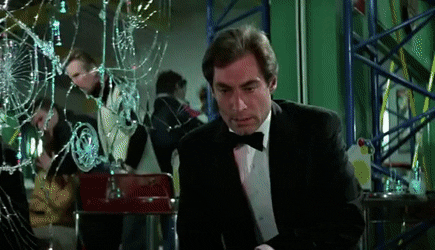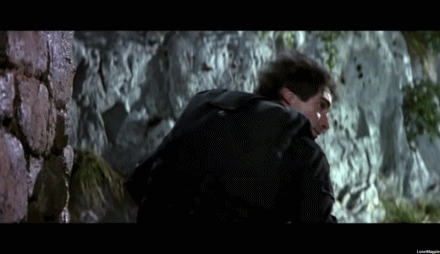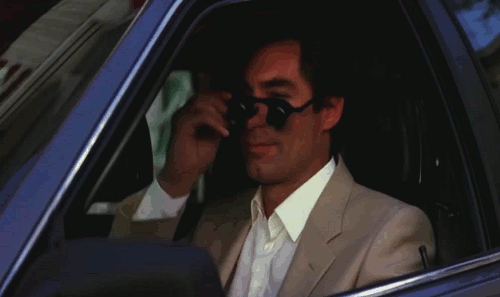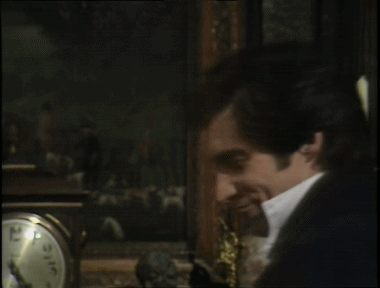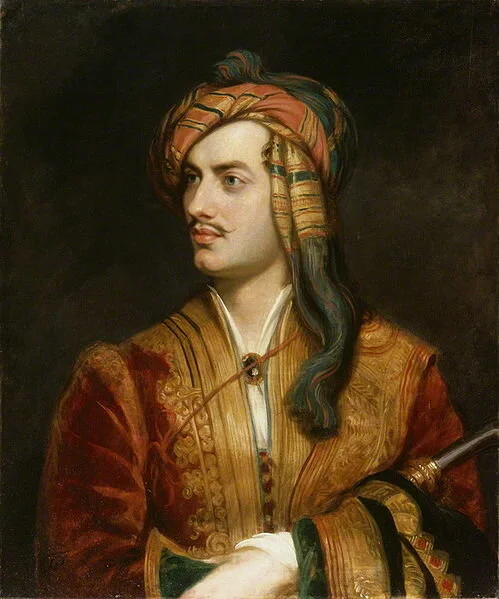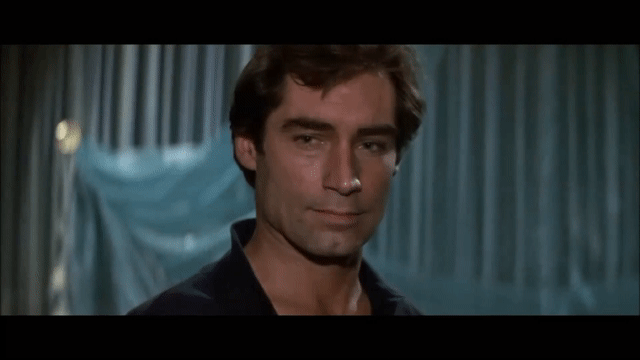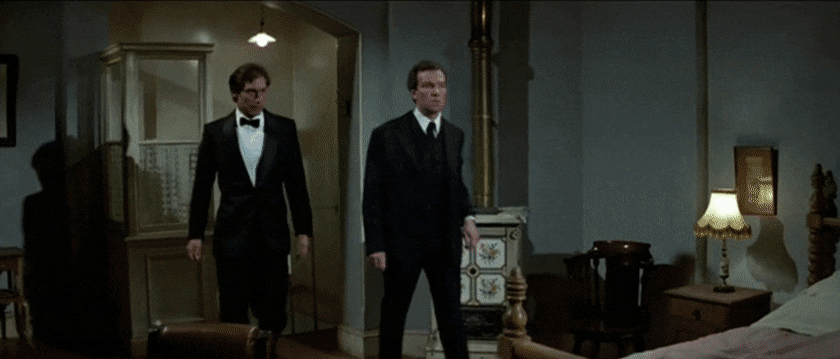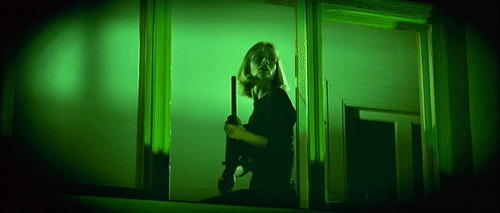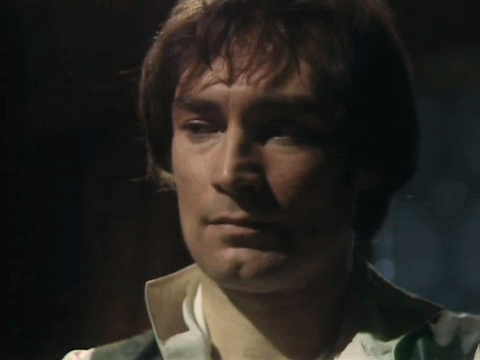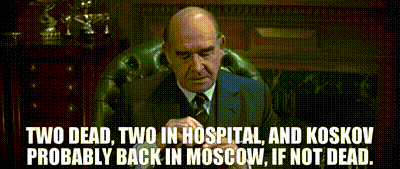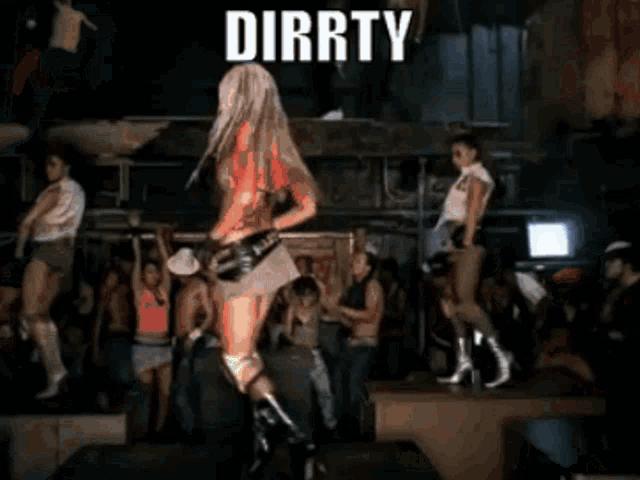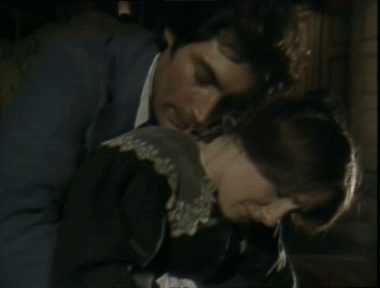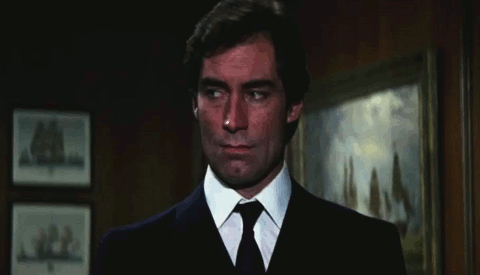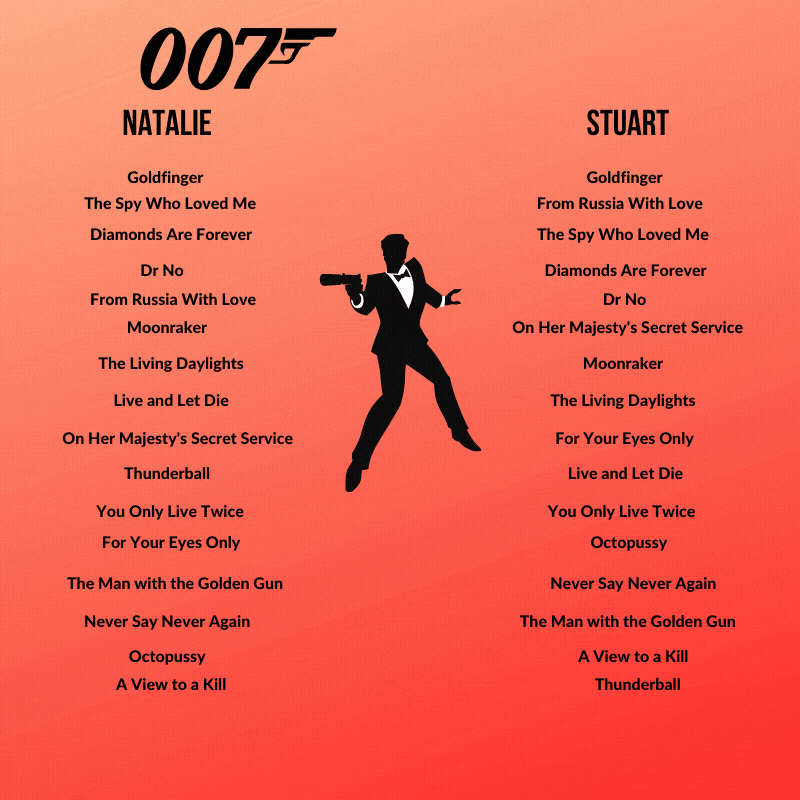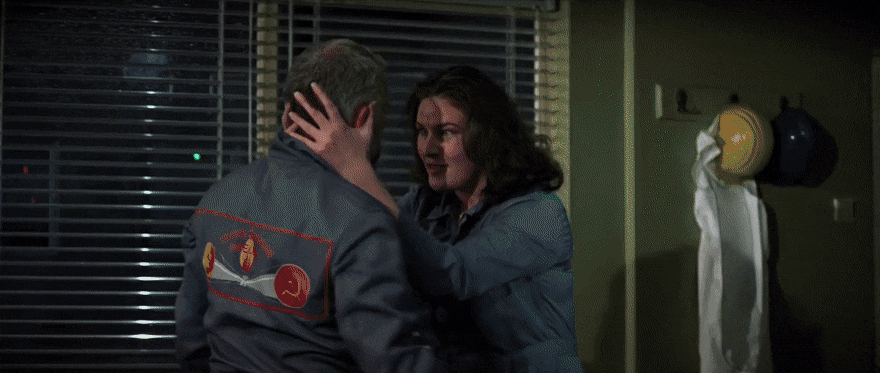Listen to the companion Raven Bond podcast here!
Released: June 1987
Producer: Albert R Broccoli and Michael G Wilson
Director: John Glen
Written by: Richard Maibaum and Michael G Wilson
Plot:
When James Bond is called in to assist in the defection of a top KGB officer from a Bratislava concert, he begins to smell a rat. General Koskov insists the new KGB chief Pushkin has gone mad with power, and the rest of the British government is keen to have him officially offed. But ever the keen-eye, Bond works out that the beautiful blonde cellist “sniper” is actually Koskov’s lover, and is a pawn in Koskov’s bigger game. Eventually Bond and Kara Milovy end up in Afghanistan, where the extent of Koskov and his American wannabe general friend Whittaker’s plan is revealed, and it’s got a lot to do with a shitload of opium.
Famous For:
Almost a soft reboot of the franchise
Whittaker’s war fetish and wax statues
A cello case toboggan race
THAT FACE
Reader, I wanted to finish this essay sooner, really I did. But you must understand the bewitchment that befell me with the appearance of Timothy Dalton in the Bond franchise.
It wasn’t like he was an unknown - for years my mother had faithfully described Dalton as her favourite, and the most handsome, James Bond. Sure, I remembered him as a good-looking, agile Bond, but it was only viewing The Living Daylights for the first time in years that made me truly get the Dalton knee trembles.
I quickly fell into a YouTube rabbit hole of the Dalton oeuvre, particularly his early UK television work as a number of legendary literary characters, such as Heathcliff in 1970’s Wuthering Heights and Mr Rochester in 1983’s Jane Eyre. That’s right, the man was a Brontë dreamboat.
Feeling cute, might propose a bigamist marriage later.
Having long been considered for the Bond role, and having been known for shit-talking the series in public (he famously noted he was glad he didn’t take on the part for Moonraker, because it was too silly), Dalton finally signed on after Roger Moore went out to pasture, and Pierce Brosnan’s contract was foiled by his recall to the TV detective series Remington Steele.
He ignored the Connery and Moore performances and instead returned to Ian Fleming’s books, surprising himself with how much he liked the original character. He drew his Bond from those sources, and added a key new element drawn from his classical work.
Timothy Dalton gave us James Bond as a Byronic Hero.
Feeling cute, might propose incest with my half-sister later.
Some hack named Kingsley Amis drew this Bond/Byron connection long before I did. In his 1965 book The James Bond Dossier, Amis described 007 in the novels as “Lonely, melancholy, of fine natural physique, which has become in some way ravaged ... dark and brooding in expression, of a cold and cynical veneer, above all enigmatic, in possession of a sinister secret.”
That was written describing the Bond of the books. By 1965, only Sean Connery had been in the movies, and the easy charm of Roger Moore was yet to come.
So while Connery had established the idea of light and dark present in the Bond character, I would argue that it was Dalton who brought a true Byronic sensibility to the cinematic role by enhancing that nuance, and adding in one other factor:
Connery’s Bond never struggled with self-loathing. Dalton’s Bond positively reeks of it.
Oh, James.
Ian Fleming once wrote about not wanting people to “fall in love” with Bond because he’s a bad man who does bad things. Well Flemmo, too bad on this one. It turns out when you combine a resourceful, enigmatic and dangerous hero with a 19th century f***boy aesthetic, it turns out you hit the Natalie Bochenski Patented Sweet Spot for Goosebumps and Girlish Giggles.
Don’t worry, I haven’t forgotten… The One. Well, The One While it Lasted.
After a slightly dry and crusty end to Roger Moore’s time in the tux, The Living Daylights by comparison is like a restorative wet t-shirt competition.
It boggles the mind to realise it’s the same writing team - Richard Maibaum and producer/Cubby Broccoli’s stepson Michael G. Wilson - that produced the later Moore films. Clearly Dalton’s determination to inject more realism into the character and story had an effect. Indeed, an early idea tossed around was to make it a prequel film, but that was shelved in favour of what is essentially a soft gritty reboot.
The Living Daylights makes a return to real East-West espionage drama, set against the broader dynamic of mid-80s glasnost. It also revives the SMERSH element from early Fleming books, re-routing the “Death to Spies” operation from a deadly intelligence agency to a couple of jumped-up con artists in the shape of General Koskov and Brad Whittaker, an American military fantasist and arms dealer. Whittaker’s highly effective henchman - a man whose Walkman provides not only sweet tunes by a sweet headphone wire garrotte - is scarier than both of them combined.
“I could strangle you both but I don’t want to damage the Sony.”
The pre-credit sequence, featuring Bond and two other Double-Os parachuting into the British garrison on the Rock of Gibraltar, leads into the main story, with one of Bond’s fellow agents murdered by a saboteur, who leaves a "Smiert Shpionam” calling card on the body.
Only Bond survives to kill the assassin, drop in on a bored glamour girl, and almost throw away his first-ever “Bond. James Bond.”
This is really the only moment that Bond is a bit flirty and a bit saucy, because this Bond is something inconceivable just a few years’ earlier - a one woman man. But more on that later.
After the success of Duran Duran with A View to a Kill, Eon wisely chose another chart-topping group to write the theme song - Norwegian pop trio A-ha. Best known for its much-loved and heavily-parodied Take On Me, the band became the only non-British or American act to perform a Bond song. A-ha reportedly didn’t get on super well with composer John Barry, who unbeknownst to anyone at the time, was working on his final Bond score. Still, what they came up with together was a certified Scandi New Wave banger:
Bond is deployed to Bratislava to assist local MI6 agent Saunders with General Koskov’s defection. Koskov insisted Bond be a part of the protection detail; his job is to shoot down any KGB snipers that might try to stop the general’s escape.
Bond arrives in a tuxedo and reveals a handy shirt blackout collar accessory.
Why is this so damn sexy…sweet lord, I need a cold shower.
But when the expected sniper is revealed to be an angelic-looking cellist, Bond shoots the rifle out of her hand, potentially compromising the mission.
I guess you could say, uh, she struck a chord with him.
Luckily he was prepared, and had a much better escape route for Koskov than the back of Saunders’ car. With the help of a friend on the inside, Bond bundles the KGB officer into a specially designed container and fires him through an oil pipeline across the border into Austria. He’s met by Q and immediately spirited off to Blighty in a ooh-how-fancy Harrier Jump Jet.
Bond and Saunders then make their way across the border by car, during which time the latter berates Bond for not killing the sniper as ordered. From 3.25 minutes in this clip, Bond is seen telling Saunders “stuff my orders” and that he only kills professionals. And he continues…
”Go ahead, tell M what you want. If he fires me, I’ll thank him for it.”
¿Qué?
James Bond, cynically flipping off direct orders and expressing a weariness about his line of work? That’s… new. That’s… dark. That’s the kind of thing a brooding, morally dubious yet anguish-ridden mid-19th century bildungsroman hero would say.
Life is pain when you’ve locked your mentally ill first wife in the attic and are trying to convince your governess that getting married is totally chill.
The spidey senses that pricked up when Bond realised the cellist was no assassin continue to tingle as he listens to Koskov’s big defection info dump at a safehouse in the English countryside.
He’s right to think something is suss, particularly when Koskov is all-too-conveniently kidnapped from the site (which includes, by the way, one of the greatest fist fights ever staged in a Bond movie that Bond is nowhere near; instead it’s Necros against a random security guard in the compound’s kitchen.
M is happy to believe the raid was a KGB job, and orders Bond to kill General Pushkin based on Koskov’s information.
But Bond, the rat right under his nostrils now, doesn’t buy that Pushkin has gone power-mad. As ever, his brain works faster and sharper than the others, who are hoping to save face after Koskov’s loss turned all of theirs red.
His internal turmoil is on fine display during a stunning sequence in Tangier, when he launches a sneak attack on Pushkin by hijacking a planned rendezvous with his lady friend.
Bond knows something is fishy with Koskov’s story, and yet must present at least some threat to Pushkin to get him to talk. When the General alerts his security guard via a button on his watch, Bond is furious. Here he is, trying to establish communication and Pushkin goes and acts like an idiot.
Having not seen the film in a while, there was genuine tension in that moment when Pushkin says, almost sadly, “Then I must die”. It’s a real credit to British character actor and future fighting dwarf John Rhys Davies that he makes Pushkin a believable “Good Russian”, as opposed to the often cartoonish scoundrels the Bond films make anyone from the USSR out to be.
It’s also very telling about Dalton’s Bond that while he uses Pushkin’s lover as a distraction for the guard, tearing off her robe and leaving her standing in her altogethers facing the door, he seems apologetic after the fact. He throws her torn robe back to her and tells her to lock herself in the bathroom. It’s a small thing, but it shows 007 not only wanting to privacy for his espionage work, but wanting to avoid exposing an innocent party to any more trauma at the sight of him in full dirty spy mode.
Of course, I would be very much down for this Bond to get very, very, dirty.
2002 really was a red letter year for Christina’s gusset work.
Sadly for me his complex moral code kicks in to gear when it comes to Kara Milovy, The Living Daylights’ luscious leading lady.
Yes, perhaps the most surprising aspect of The Living Daylights - but the one that ties Dalton most to his Byronic hero roots - is that it’s incredibly romantic.
Dalton’s demand that his Bond not shag every passing fancy allows his relationship with Kara Milovy to unfurl and spread its wings like Bach’s Cello Suite Number One.
His instincts that she was duped by Koskov prove right, but what is incredible about this Bond is that he doesn’t blame her, or shake her down for information straight away. Sure, he kinda lies to her by saying he’s Koskov’s friend and has been entrusted to take her to him, but in fairness he is on a mission and she is mixed up with potential bad guys somehow.
For her part, Maryam D’Abo does a wonderful job in portraying Kara’s naivety without coming across as stupid, or worse still, boring. She’s idealistic and believes Koskov to be her noble lover, giving her a Stradivarius and also an expensive cello. BOOM! STRING INSTRUMENT SEX PUN!
Yo-Yo HA!
There’s a frustrated “Women!” from Bond when Kara insists she won’t leave Bratislava without her precious cello, but Bond is forced to eat his sexism when it turns out that self-same instrument comes in very handy during their border crossing. Forced to ditch his updated Aston Martin in the mountains after a spectacular chase - including an ice lake battle that clearly inspired a similar sequence in Die Another Day - he and Kara toboggan to freedom using the case as a sled and the instrument as a rudder.
It’s in Vienna that their romance blossoms, with Bond pretending Koskov is paying for a new dress, and tickets to a concert, and a spin around rides in the city’s famous Prater amusement park. Bond may be canvassing Kara for information, but he’s still very much into the artwork he can create with her.
It comes onboard a Ferris Wheel, which Bond has stop at the top so they can MACK ON. The line “Don’t think, just let it happen” is kind of weird, but Kara proceeds it by saying she’s only known him two days and can’t stop thinking about what could happen between them, so I’m willing to forgive it. Besides, the kiss that follows is so enticing, it’s actually quite insulting that the camera pans away to the elephant Bond won for Kara at the shoot ‘em up carnival game.
Their time in Vienna is cut short when Saunders is murdered by Necros, a “Smiert Shpionam” balloon bouncing conveniently nearby for Bond to find.
Never thought I’d fantasise about being a balloon, yet here we are.
After helping carry out the fake assassination of Pushkin, designed to provoke Koskov and Whittaker to act, it’s Bond who comes a cropper at the hand of Kara, not the other way around.
Scared and alone, she calls Koskov, who convinces her Bond is a KGB agent out to get him. This all happens onscreen - the moment we realise is when Bond himself does, as the drug she put in his drink takes hold.
Dalton plays this moment beautifully - he tears Kara’s sleeve to prove to her he knows she has a wound there from when he shot the rifle out of her hand during Koskov’s defection. Too late, she realises she’s done him wrong. As Koskov bursts in with heavies, Bond pulls his weapon out (his gun, you perverts) and tries to focus enough to shoot. But it’s too late, and he collapses.
When he wakes on an aeroplane on the way to Afghanistan, Kara apologises for being a fool. He is not angry, rather he grasps her hand and says he’s been a fool as well.
¿Qué?
James Bond admitting his wrongs? Being… tender? That’s almost what a proud yet misguided gentleman landowner might do after he finally reveals key information about his past that would have been good to know sooner.
Look I know our wedding was just interrupted by the brother of my mad first wife alerting you to her existence, but that whole marriage was a set-up, and I’m sorry, and can’t I just breathe down your neck like this forever?
Koskov locks Bond and Kara up at the Soviet base in Afghanistan, ready to be packed off back to Moscow to face punishment. But thanks to Bond’s whistle-happy keychain smoke bomb, and a few timely knocks from Kara, the pair is able to escape, freeing a local facing execution in the morning.
That local turns out to be British-educated Afghan bad boy Kamran Shah, played by British-Pakistani actor Art Malik wearing the role of a handsome freedom fighter like a glove.
Before you ask, yes, I am exactly the type of person who would say “lucky horse”.
Shah and his Mujahideen mates welcome Bond to their headquarters, amidst much whooping at Shah’s return.
It’s here that the romance between Bond and Kara experiences a gorgeously rocky moment. Bond wants to return to the airbase to stop Koskov, but doesn’t want to risk Kara’s safety, so plans to send her off with Shah to the Khyber Pass.
But Kara isn’t having it, and beats Bond up with a pillow while calling him names in Czech. When Bond realises she’s calling him a horse’s arse, all anger dissolves and it’s clear the pair genuinely care for each other. Maybe it’s the Arabic-inspired decor and soft furnishings, but this scene is totally swoon-worthy.
Now look, The Living Daylights is by no means perfect. Some critics at the time lamented a reduction in the series’ trademark humour, but I think in hindsight that complaint doesn’t hold up. It is true that Dalton has far fewer puns than Moore and even Connery, and his delivery almost throws them away, avoiding any sly winking at the camera.
A more legitimate criticism is that the third act in Afghanistan, which sees the espionage and SMERSH plot expand into a broader scheme of opium smuggling being used to finance arms trading, bulks out the back end of the movie.
It’s lucky then, that the opium swap drops give way to a great rebellion scene led by Kara herself, who grabs a rifle and chases after Bond on horseback as he is trucked away in the back of an opium wagon. Shah calls back to an earlier exclamation of frustration with another “Women!”, before leading his men on a smash and bash raid back at the USSR air base.
It’s also a nice touch that Bond’s plan to blow up the opium fails first in the wagon, and then again on the giant goods plane set to carry the $500 million in raw poppy extract to the West. As he tries to leave the plane, he runs right into Koskov and Necros, and so has to immediately knock out the pilots and try to fly the damn thing off.
Kara joins him via speedy Jeep onramping, and all seems clear - until Necros shows up. After a mighty fight on a net full of opium hanging out of the back of the plane, Bond manages to give him the boot and finally find a use for his bomb - blowing up a bridge to stop the Russians getting at the Mujahideen. He and Kara then offramp the Jeep spectacularly, just in time to make dinner in Karachi.
Another criticism that’s fair to raise is the relative softness of Whittaker as a villain. His narcissistic toy soldier collecting ways are genuinely original to the franchise, and his pathetic playing-at-general inspires some fun visuals. His introduction to General Pushkin in Tangiers is just brilliant, with Pushkin revolted by Whittaker’s clear delight in putting his own face on the world’s most terrifying military commanders/slayers of men.
But Bond’s final shoot-out with Whittaker in his GI Joe Fun House seems smaller in the stakes department, considering Bond and Kara just escaped Afghanistan by parachuting a Jeep out of a goods plane. Although Whittaker being crushed beneath a collapsing statue of the Duke of Wellington onto the table featuring his most famous battle is *chef’s kiss* delicious. “He met his Waterloo.” Perfect.
General Koskov himself survives the movie, sent back to Moscow by Pushkin “in the diplomatic bag” after attempting to grovel his way out of the situation. An option suited to Koskov’s cowardly, vindictive nature, but something of an anti-climax for Bond’s usual style. Still, it implies Koskov will get his real comeuppance from the Soviets he betrayed, which is no doubt far more unpleasant than death at Bond’s hands.
The whole thing wraps up with Kara all of a sudden a global cellist superstar, playing somewhere that M, General Gogol (retired from the KGB and now a Soviet diplomat) and Shah and his magazine-wearing Mujahideen can all rock up to. So… London?
Kara is sad James isn’t there, but there’s a surprise waiting for her in her dressing room, and it can be summoned by a wolf whistle.
Now look, maybe he did get in late, but it does look awfully like Bond just wanted to skip the music and get straight to the snogging. It’s lucky then that Dalton conveys a genuine sense of being happy to be reunited with Kara, almost to the point of thinking maybe this is a relationship Bond could stick out, and maybe his self-loathing would ease, just a little.
Of course it doesn’t, because while Bond might be able to be a one-woman man in one film, he’s got a reputation - and a franchise - to maintain.
So the Byronic hero resets to zero. Let the brooding re-commence.
And now that I’ve got all of that pent-up period drama excitement out of my system, I’m sure I will be mature and responsible in how I discuss Timothy Dalton going forward.
Thank you for reading this instalment of the James Bond Retrospective! If you enjoyed it, you can sign up to support the series and my other writing/podcasting efforts via my Patreon page. Thanks to all of you who are already members; your support is truly invaluable. You can listen to the companion Raven Bond The Living Daylights podcast here:
Stu and I have are also ranking the Bond films as we watch and podcast about them. Here’s how we stand:
Finally, I couldn’t find the right place to put these in the main body of the essay, but I just want to shout out the fantastic pipeline worker who creatively distracts a colleague to help Bond get Koskov out:
…and Q’s utterly delightful and onbrand 80s invention - the Ghetto Blaster:
Join us next time for the end of the all-too-brief Dalton era with Licence to Kill!
